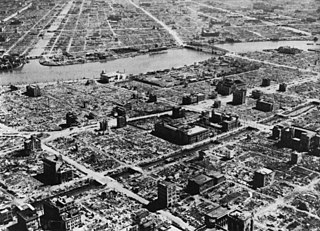
Strategic bombing is a systematically organized and executed attack from the air which can utilize strategic bombers, long- or medium-range missiles, or nuclear-armed fighter-bomber aircraft to attack targets deemed vital to the enemy's war-making capability. It is a military strategy used in total war with the goal of defeating the enemy by destroying its morale, its economic ability to produce and transport materiel to the theatres of military operations, or both. The term terror bombing is used to describe the strategic bombing of civilian targets without military value, in the hope of damaging an enemy's morale.

The bombing of Dresden was a joint British and American aerial bombing attack on the city of Dresden, the capital of the German state of Saxony, during World War II. In four raids between 13 and 15 February 1945, 772 heavy bombers of the Royal Air Force (RAF) and 527 of the United States Army Air Forces (USAAF) dropped more than 3,900 tons of high-explosive bombs and incendiary devices on the city. The bombing and the resulting firestorm destroyed more than 1,600 acres (6.5 km2) of the city centre. Up to 25,000 people were killed. Three more USAAF air raids followed, two occurring on 2 March aimed at the city's railway marshalling yard and one smaller raid on 17 April aimed at industrial areas.

The Blitz was a German bombing campaign against the United Kingdom, in 1940 and 1941, during the Second World War. The term was first used by the British press and originated from the term Blitzkrieg, the German word meaning 'lightning war'.
The Baedeker Blitz or Baedeker raids was a series of aerial attacks in April and May 1942 by the German Luftwaffe on English cities during the Second World War. The name derives from Baedeker, a series of German tourist guide books, including detailed maps, which were used to select targets for bombing.

Patrick Maynard Stuart Blackett, Baron Blackett,, was a British experimental physicist known for his work on cloud chambers, cosmic rays, and paleomagnetism, awarded the Nobel Prize in Physics in 1948. In 1925 he became the first person to prove that radioactivity could cause the nuclear transmutation of one chemical element to another. He also made a major contribution in World War II advising on military strategy and developing operational research. His views saw an outlet in third world development and in influencing policy in the Labour government of the 1960s.
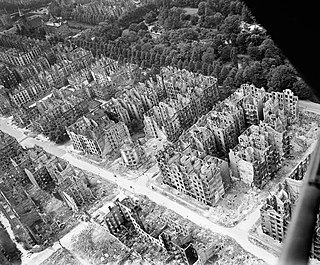
The Allied bombing of Hamburg during World War II included numerous attacks on civilians and civic infrastructure. As a large city and industrial centre, Hamburg's shipyards, U-boat pens, and the Hamburg-Harburg area oil refineries were attacked throughout the war.
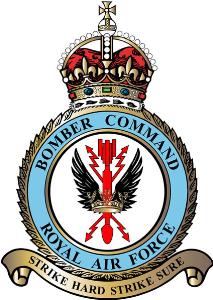
RAF Bomber Command controlled the Royal Air Force's bomber forces from 1936 to 1968. Along with the United States Army Air Forces, it played the central role in the strategic bombing of Germany in World War II. From 1942 onward, the British bombing campaign against Germany became less restrictive and increasingly targeted industrial sites and the civilian manpower base essential for German war production. In total 364,514 operational sorties were flown, 1,030,500 tons of bombs were dropped and 8,325 aircraft lost in action. Bomber Command crews also suffered a high casualty rate: 55,573 were killed out of a total of 125,000 aircrew, a 44.4% death rate. A further 8,403 men were wounded in action, and 9,838 became prisoners of war.

World War II (1939–1945) involved sustained strategic bombing of railways, harbours, cities, workers' and civilian housing, and industrial districts in enemy territory. Strategic bombing as a military strategy is distinct both from close air support of ground forces and from tactical air power. During World War II, many military strategists of air power believed that air forces could win major victories by attacking industrial and political infrastructure, rather than purely military targets. Strategic bombing often involved bombing areas inhabited by civilians, and some campaigns were deliberately designed to target civilian populations in order to terrorize them and disrupt their usual activities. International law at the outset of World War II did not specifically forbid the aerial bombardment of cities – despite the prior occurrence of such bombing during World War I (1914–1918), the Spanish Civil War (1936–1939), and the Second Sino-Japanese War (1937–1945).
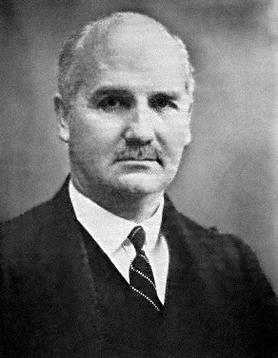
Frederick Alexander Lindemann, 1st Viscount Cherwell, was a British physicist who was prime scientific adviser to Winston Churchill in World War II.

Berlin, the capital of Nazi Germany, was subject to 363 air raids during the Second World War. It was bombed by the RAF Bomber Command between 1940 and 1945, the United States Army Air Forces' Eighth Air Force between 1943 and 1945, and the French Air Force in 1940 and between 1944 and 1945 as part of the Allied campaign of strategic bombing of Germany. It was also attacked by aircraft of the Red Air Force in 1941 and particularly in 1945, as Soviet forces closed on the city. British bombers dropped 45,517 tons of bombs, while American aircraft dropped 22,090.3 tons. As the bombings continued, more and more people fled the city. By May 1945, 1.7 million people had fled.

H2S was the first airborne, ground scanning radar system. It was developed for the Royal Air Force's Bomber Command during World War II to identify targets on the ground for night and all-weather bombing. This allowed attacks outside the range of the various radio navigation aids like Gee or Oboe, which were limited to about 350 kilometres (220 mi) of range from various base stations. It was also widely used as a general navigation system, allowing landmarks to be identified at long range.

The Butt Report, released on 18 August 1941, was a report prepared during World War II, revealing the widespread failure of RAF Bomber Command aircraft to hit their targets.
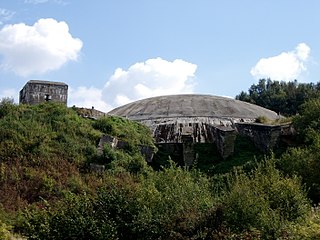
Crossbow was the code name in World War II for Anglo-American operations against the German long range reprisal weapons (V-weapons) programme. The primary V-weapons were the V-1 flying bomb and V-2 rocket, which were launched against Britain from 1944 to 1945 and used against continental European targets as well.

The Area Bombing Directive was a directive from the wartime British Government's Air Ministry to the Royal Air Force, which ordered RAF Bomber Command to destroy Germany's industrial workforce and the morale of the German population, through bombing German cities and their civilian inhabitants.
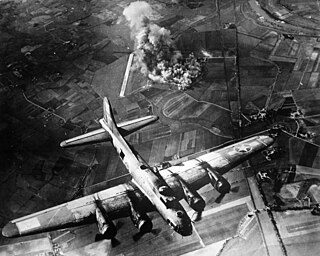
The Combined Bomber Offensive (CBO) was an Allied offensive of strategic bombing during World War II in Europe. The primary portion of the CBO was directed against Luftwaffe targets which was the highest priority from June 1943 to 1 April 1944. The subsequent highest priority campaigns were against V-weapon installations and petroleum, oil, and lubrication (POL) plants. Additional CBO targets included railyards and other transportation targets, particularly prior to the invasion of Normandy and, along with army equipment, in the final stages of the war in Europe.
David Miles Bensusan-Butt was an English economist who spent much of his career in Australia. Known as David, he published his work as D. M. Bensusan-Butt.

The Defence of the Reich is the name given to the strategic defensive aerial campaign fought by the Luftwaffe of Nazi Germany over German-occupied Europe and Germany during World War II. Its aim was to prevent the destruction of German civilians, military and civil industries by the Western Allies. The day and night air battles over Germany during the war involved thousands of aircraft, units and aerial engagements to counter the Allied strategic bombing campaign. The campaign was one of the longest in the history of aerial warfare and with the Battle of the Atlantic and the Allied Blockade of Germany was the longest of the war. The Luftwaffe fighter force defended the airspace of German-occupied territory against attack, first by RAF Bomber Command and then against the United States Army Air Forces (USAAF) in the Combined Bomber Offensive.
The Casablanca directive was approved by the Combined Chiefs of Staff (CCOS) of the Western Allies at their 65th meeting on 21 January 1943 and issued to the appropriate Royal Air Force and United States Army Air Forces commanders on 4 February 1943. It remained in force until 17 April 1944, when the Allied strategic bomber commands based in Britain were directed to help with preparations for Operation Overlord.

The Allied oil campaign of World War II pitted the RAF and the USAAF against facilities supplying Nazi Germany with petroleum, oil, and lubrication (POL) products. It formed part of the immense Allied strategic bombing effort during the war. The targets in Germany and in Axis-controlled Europe included refineries, synthetic-fuel factories, storage depots and other POL-infrastructure.

Marshal of the Royal Air Force Sir Arthur Travers Harris, 1st Baronet,, commonly known as "Bomber" Harris by the press and often within the RAF as "Butch" Harris, was Air Officer Commanding-in-Chief (AOC-in-C) RAF Bomber Command during the height of the Anglo-American strategic bombing campaign against Nazi Germany in the Second World War.
















